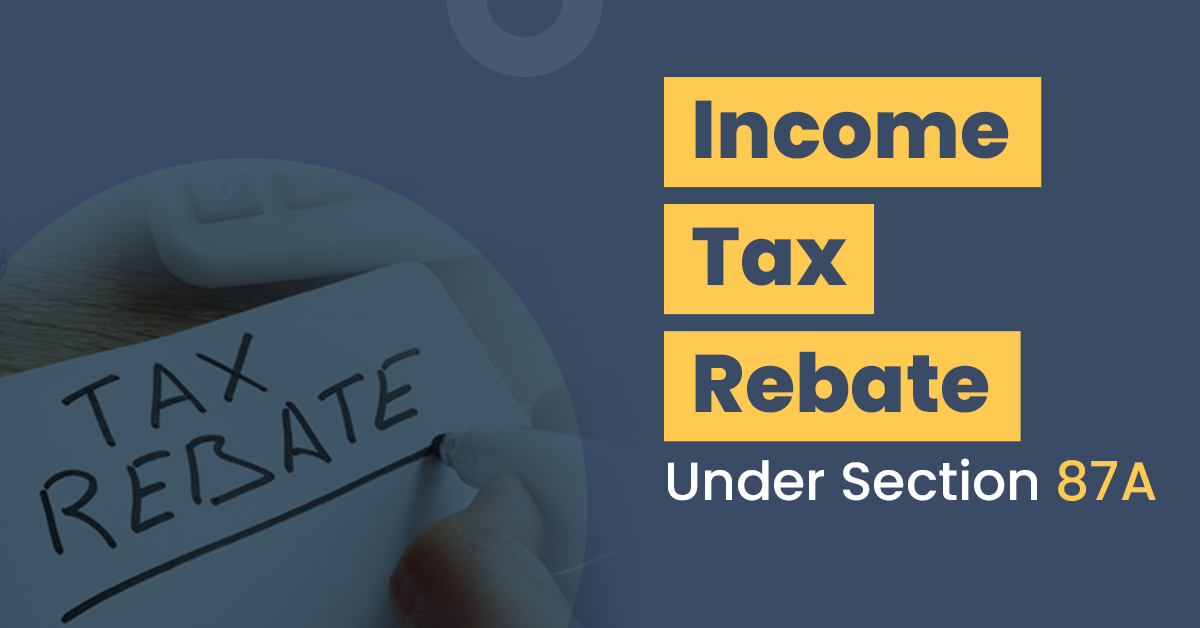Income Tax Rebate Under Section 87A of the Income Tax Act


To provide tax relief to individual taxpayers in the 5% tax slab, section 87A provides a tax rebate from the total tax liability of an assessee, a resident individual in India whose total income is not more than ₹5,00,000. Such a rebate shall equal the income tax payable on the total income for any assessment year or the prescribed limit of ₹12,500, whichever is less. This rebate is allowed from tax payable before adding Health and education expenses to income tax.
The amount of rebate under this section has been revised over the years. Recently, in the 2023 budget, the government expanded the net taxable income limit to ₹7,00,000 with a maximum rebate amount of ₹25,000.
Income Tax Rebate: Meaning
In simple terms, an Income tax rebate is a form of a refund on tax which you need to pay to the income tax department. You can avail of the rebate in your income tax if you have paid more than you owe to the government.
If you want to claim your income tax rebate, you should file your income tax return within the time the government prescribes and compute your tax liability accurately.
Income Tax Rebate Under Section 87A For FY 2022-23
The basic exemption limit from tax payment is ₹2,50,000. You will be liable to pay income tax if your income exceeds this limit.
This section provides the benefit of your tax liability if your taxable income in a financial year is not more than ₹5,00,000. It ultimately means that if your taxable income exceeds the limit of ₹5,00,000, you will not be eligible for any tax benefit under this section.
You can better understand this section with this example. If your tax liability is ₹2,500, your rebate will also be ₹2,500. If your tax liability is ₹10,000, your refund will be ₹10,000. But, if your tax liability is ₹14,000, your rebate will be restricted to ₹12,500.
87A Tax Rebate under the New Regime (FY 2023-24 & AY 2024-25)
The basic exemption limit under the new income tax regime is ₹7,00,000. You will have to pay tax if your income exceeds this limit.
The rebate amount offers a tax relief of ₹25,000 if your income is ₹7,00,000 under section 87A. The limit was ₹5,00,000 even in the new regime in Fy 2022-23, but it has been updated this year.
Section 87A: Then Vs. Now
The provision of rebates under section 87A was introduced in the year 2013. It has been last updated in the Finance Act of 2019. It is crucial to note that the section has undergone various changes since its introduction.
Initially, when it was introduced, a rebate of only ₹2,000 was allowed for those whose total taxable does not exceed ₹5,00,000. The limit of ₹5,00,000 on total taxable income was amended to ₹3,50,000 in 2017–18 with a rebate of only ₹2,500.
As per the latest provision, any individual with a taxable income of less than ₹5,00,000 can benefit from this section. The rebate restricts to ₹12,500 or the actual tax liability after deductions but before the health and education cess of 4%.
With the introduction of the new tax regime, if you have a taxable income of ₹7,00,000, you can benefit from this section in the FY 2023-24. The rebate amount is limited to ₹25,000.
Who is Eligible to Avail Income Tax Rebate Under Section 87A?
The Union Budget 2023 has altered the provisions of section 87A. Individuals who satisfy the below-mentioned eligibility criteria can avail of the rebate under section 87A of The Income Tax Act.
- The taxpayer must be a resident Indian citizen. HUF or Partnership firm can not avail the benefit under section 87A.
- Senior residents over 60 but under 80 can avail of the rebate under this section.
- Only those individuals whose net taxable income does not exceed ₹5,00,000 (after deductions under sections 80C, 80D, and as specified under Chapter VI-A), and ₹7,00,000 in the new regime (without deductions) but before adding the health and education cess of 4%.
- Super senior citizens (those above 80) can not claim the rebate under section 87A.
- The maximum amount which can be claimed as a rebate under section 87A must be either the limit prescribed by the section or the actual tax liability before cess, whichever is lower.
- Rebates under section 87A shall be available under the old and new tax regimes.
Steps to Calculate Tax Rebate Under Section 87A
Now that you have learnt the meaning and eligibility to claim a rebate of section 87A, it would be pertinent to know how to claim it.
Step I: Calculate the gross total income (GTI) for the financial year.
Step II: From this, subtract your investments and savings tax deductions.
Step III: You have arrived at your total income after deductions.
Step IV: Then, declare your gross income and the deductions allowable in your ITR.
Step V: Claim a tax rebate if your total income does not exceed ₹5,00,000, & ₹7,00,000 in the new regime.
Please note that the maximum rebate you can claim under this section is ₹12,500 under the old regime. If you file your taxes under the new regime, you can get a maximum rebate of ₹25,000. Your tax liability becomes nil after claiming this rebate.
Various Tax Liabilities Under Which You Can Claim Tax Rebate Under Section 87A
Under section 87A, you can claim a tax rebate against the following liabilities:
- You can claim a tax rebate on the normal income, which is taxed per the slab rate.
- You can claim a tax rebate for your long-term capital gains under section 112 of long-term capital gains. Section 112 states that you can claim a rebate if you sell a capital asset other than listed equity shares and equity-oriented mutual funds scheme. You cannot adjust tax payable on long-term capital gain on equity shares and equity-oriented mutual fund schemes.
- You can also claim a tax rebate for your short-term capital gains under section 111A. This section will apply if you sell equity shares and equity-oriented mutual fund schemes. The rate of short-term capital gain tax is 15% flat.
Crucial Things to Know Before Availing 87A Tax Rebate
Remember the following points before availing the tax rebate under section 87A:
- You are not eligible for this tax rebate if you are an NRI.
- Only individuals can avail the benefit of Section 87A. If you are filing ITR for a firm, HUF, or corporation, you cannot use this benefit.
- 87 A rebate is available for Senior citizens (60 to 80 years), but super senior citizens (80 years and above) are not eligible.
Examples of Calculation of Rebate Under Section 87A
For a better understanding of the section, let us look at some examples of the rebate calculation under section 87A.
Example 1: X, aged 30 years, has a total income of 4,50,000, comprising their salary income and interest on a bank fixed deposit. Compute their tax liability for A.Y.2022-23.
Computation of tax liability of X for A.Y. 2022-23
| Tax on total income of ₹4,50,000 | |
| Upto ₹2,50,000 | Nil |
| (₹4,50,000 – ₹2,50,000)*5% | ₹10,000 |
| Less: Tax rebate under section 87A | (₹10,000) |
| Total Tax Liability | Nil |
Example 2: X, aged 62 years, has a total income of ₹5,80,000 for the F.Y. 2021-22. They have invested in various schemes to enjoy tax benefits of up to ₹1,50,000 in section 80C. Compute the total tax liability for X.
Computation of tax liability of Mrs Sanjana for A.Y. 2022-23
| Sources of income | Amount (₹) |
| Gross Total Income | 5,80,0000 |
| Less: Deductions under section 80C | (1,50,000) |
| Net Taxable income | 4,30,000 |
| Tax on the net taxable income | |
| Upto ₹3,00,000 | Nil |
| (4,30,000 – 3,00,000)*5% | 6,500 |
| Less: Tax rebate under section 87A | (6,500) |
| Total Tax Liability | Nil |
Since X is a senior citizen, the basic exemption limit applicable to her is ₹3,00,000.
Please note that besides 80C, taxpayers can also claim deductions under other sections of The Income Tax Act, 1961, such as section 80D (for the payment of medical health insurance premium), section 80CCD (against investment in NPS)
Rebate Limit for Various Financial Years
| Financial Year | Limit of total taxable income | Amount of rebate allowed under section 87A |
| 2023-24 | ₹7,00,000 | ₹25,000 |
| 2022-23 | ₹5,00,000 | ₹12,500 |
| 2021-22 | ₹5,00,000 | ₹12,500 |
| 2020-21 | ₹5,00,000 | ₹12,500 |
| 2019-20 | ₹5,00,000 | ₹12,500 |
| 2018-19 | ₹3,50,000 | ₹2,500 |
| 2017-18 | ₹3,50,000 | ₹2,500 |
| 2016-17 | ₹5,00,000 | ₹5,000 |
| 2015-16 | ₹5,00,000 | ₹2,000 |
| 2014-15 | ₹5,00,000 | ₹2,000 |
Conclusion
After going through this article, you must have gained insight into Section 87A of The Income Tax Act 1961. The section aims to relieve taxpayers in the 5% tax slab. Section 87A provides a rebate from the total tax liability of an assessee, being a resident individual in India whose total income is not more than ₹5,00,000 and ₹7,00,000 in the new regime for FY 2023-24.
Such a rebate shall equal the income tax payable on the total income for any assessment year or the prescribed limit of ₹12,500, and ₹25,000, in the new regime, whichever is less. Such a Rebate under section 87A is allowed from tax payable before adding Health and education cess on the tax liability.
So, follow the steps while calculating the total tax liability and check if you are eligible for the rebate. Also, various examples and frequently asked questions have been included in the article to help you understand the section better.
Frequently Asked Questions
Can NRIs also claim tax rebates under section 87A?
No, Non-Resident Indians (NRIs) cannot claim tax rebates under section 87A as this section is only for Indian resident taxpayers.
How can I calculate the rebate under section 87A?
You can calculate your amount of rebate by calculating your gross income, then you should deduct all the deductions available under sections 80C to 80U. After all these deductions, if your taxable income is less than ₹5,00,000, you can claim a tax rebate under this section up to ₹12,500 on tax payable before the health and education cess.
Am I eligible for a tax rebate on my agricultural income under section 87A?
Agriculture income is not taxable in India.
Can a firm or HUF claim an income tax rebate under section 87A?
No, a tax rebate is only meant for individual taxpayers. Hence any person other than an individual is not eligible for claiming tax rebate.







